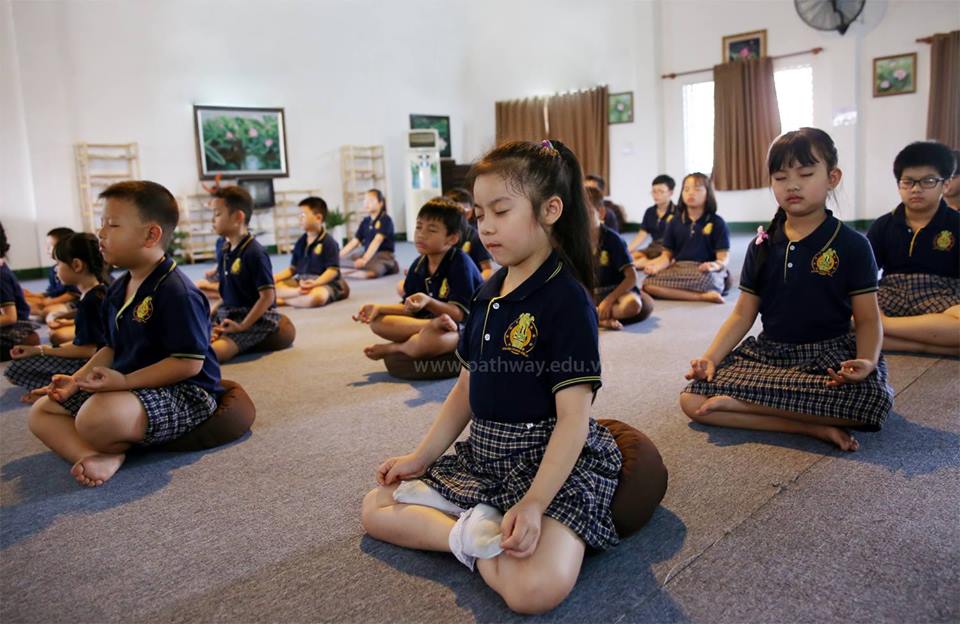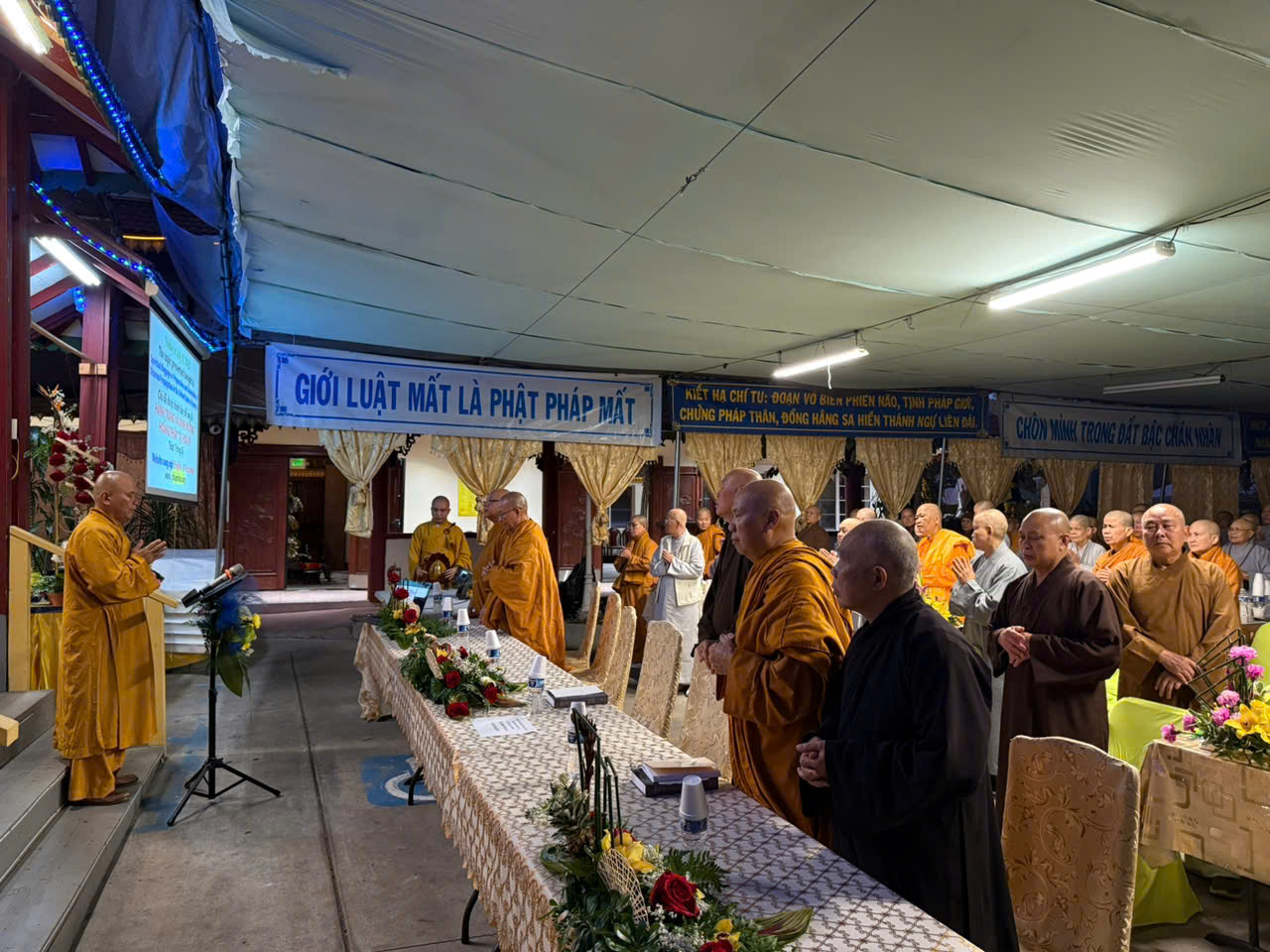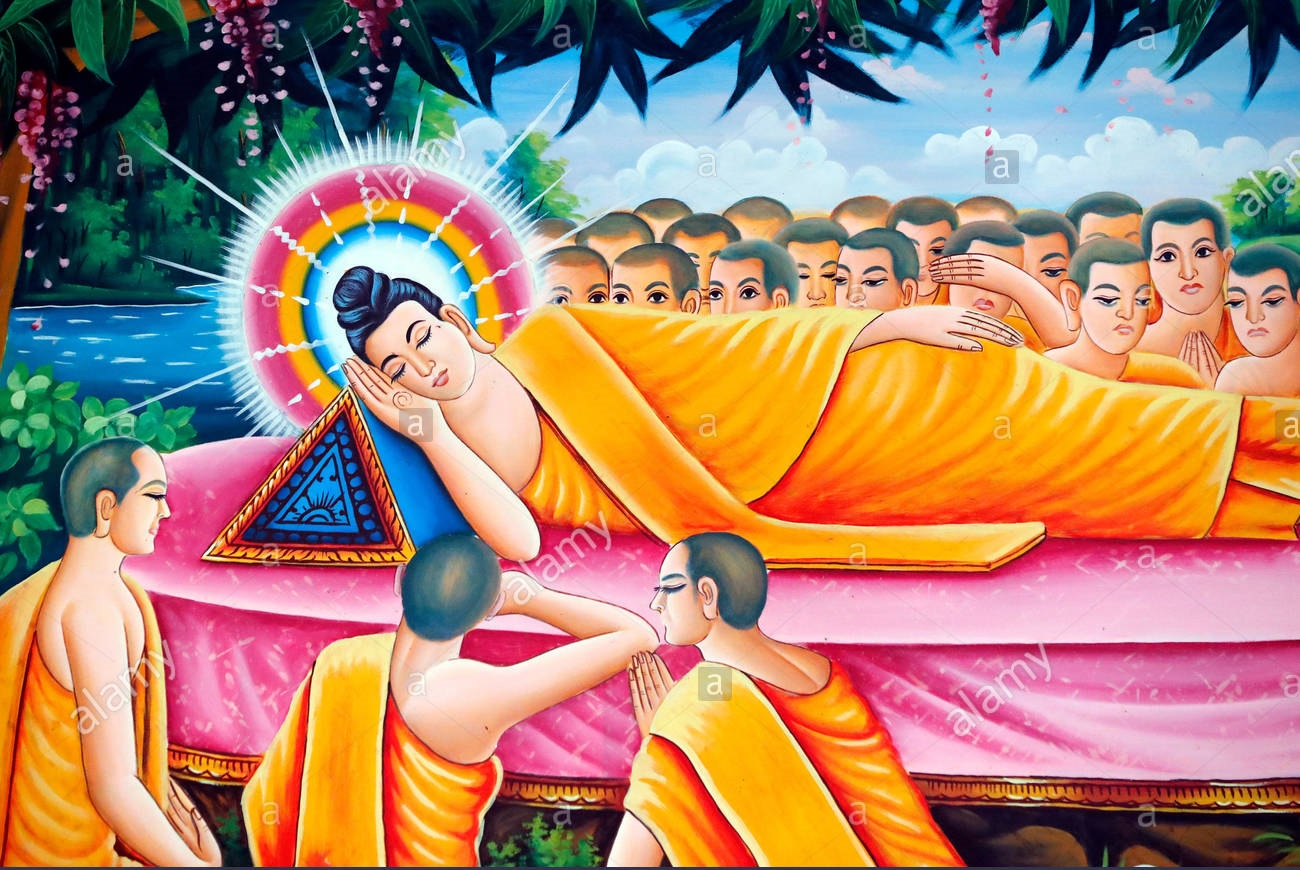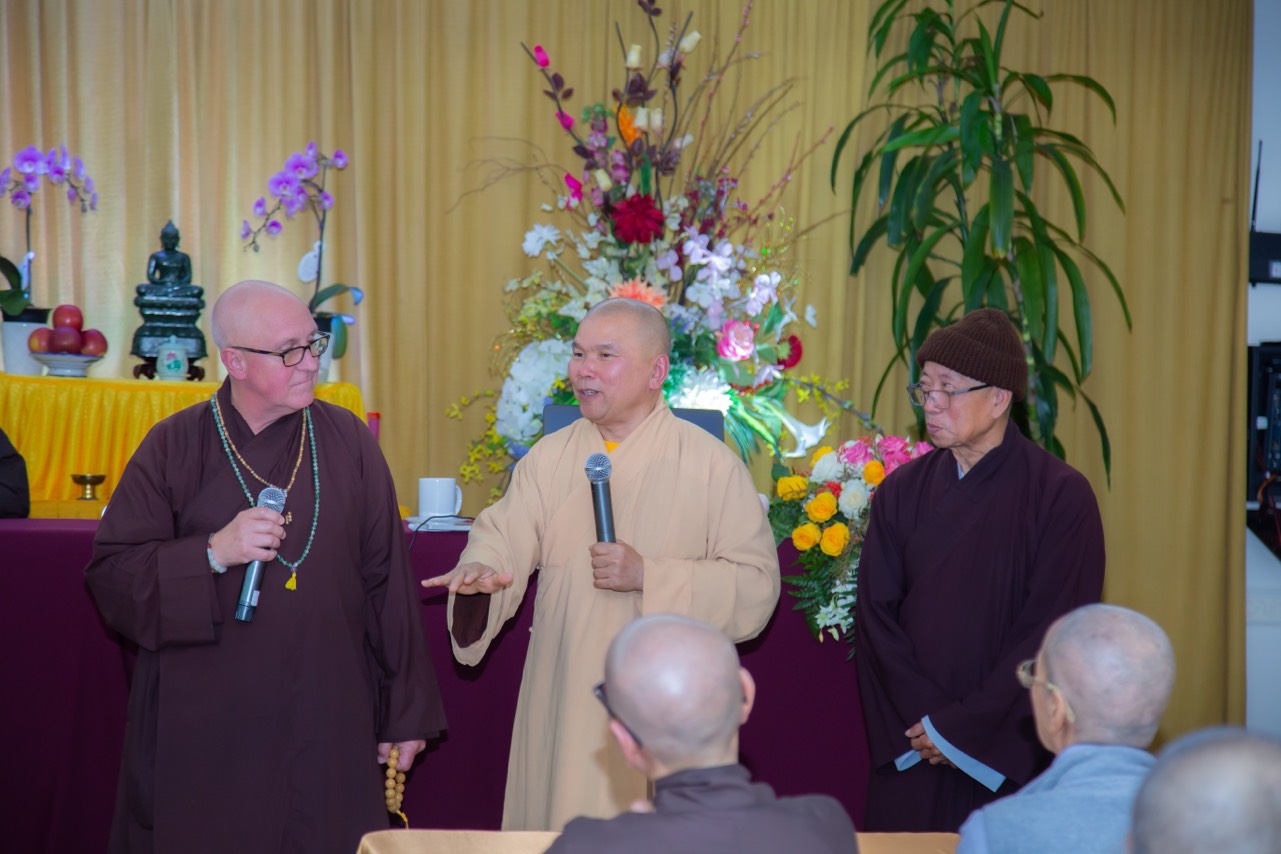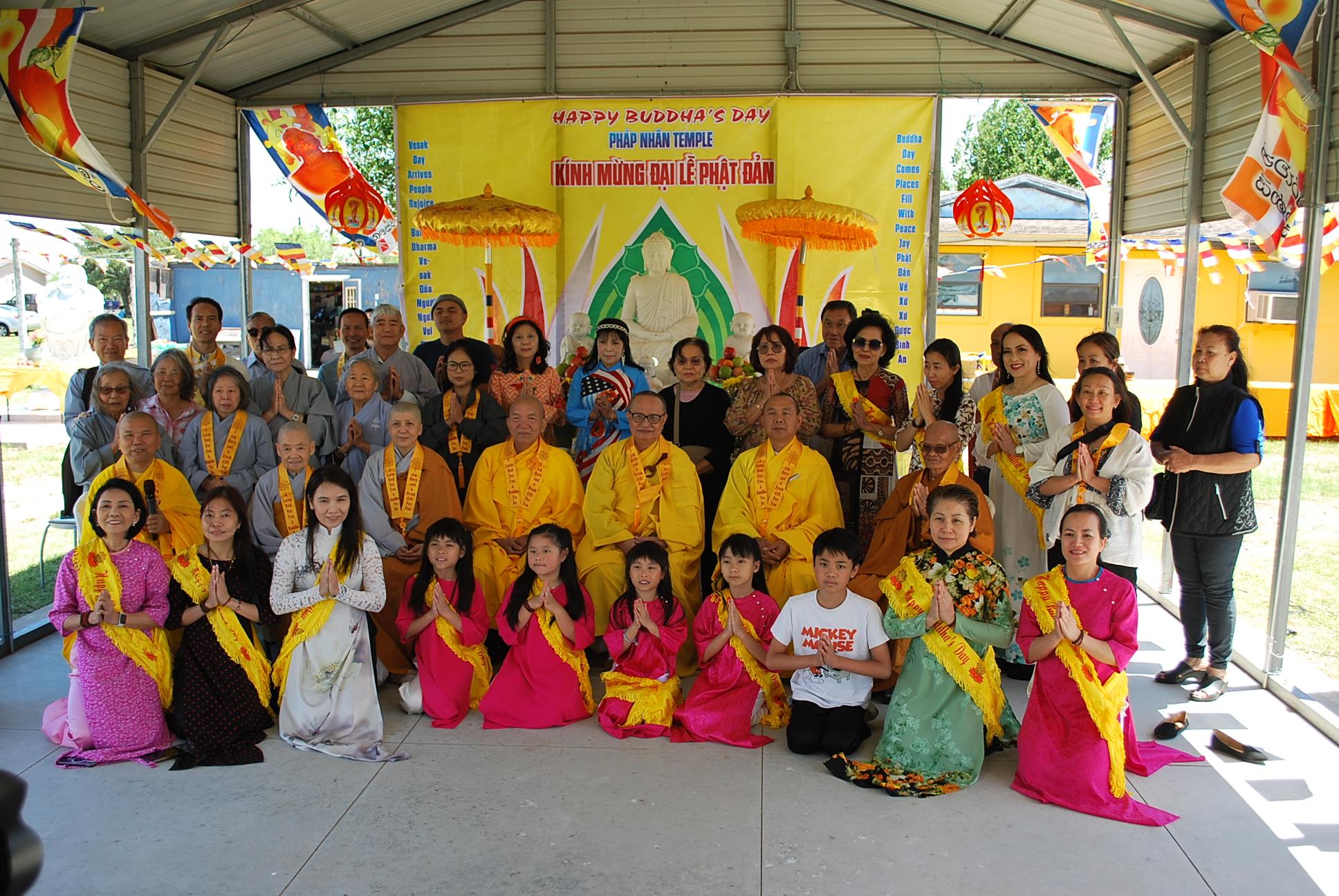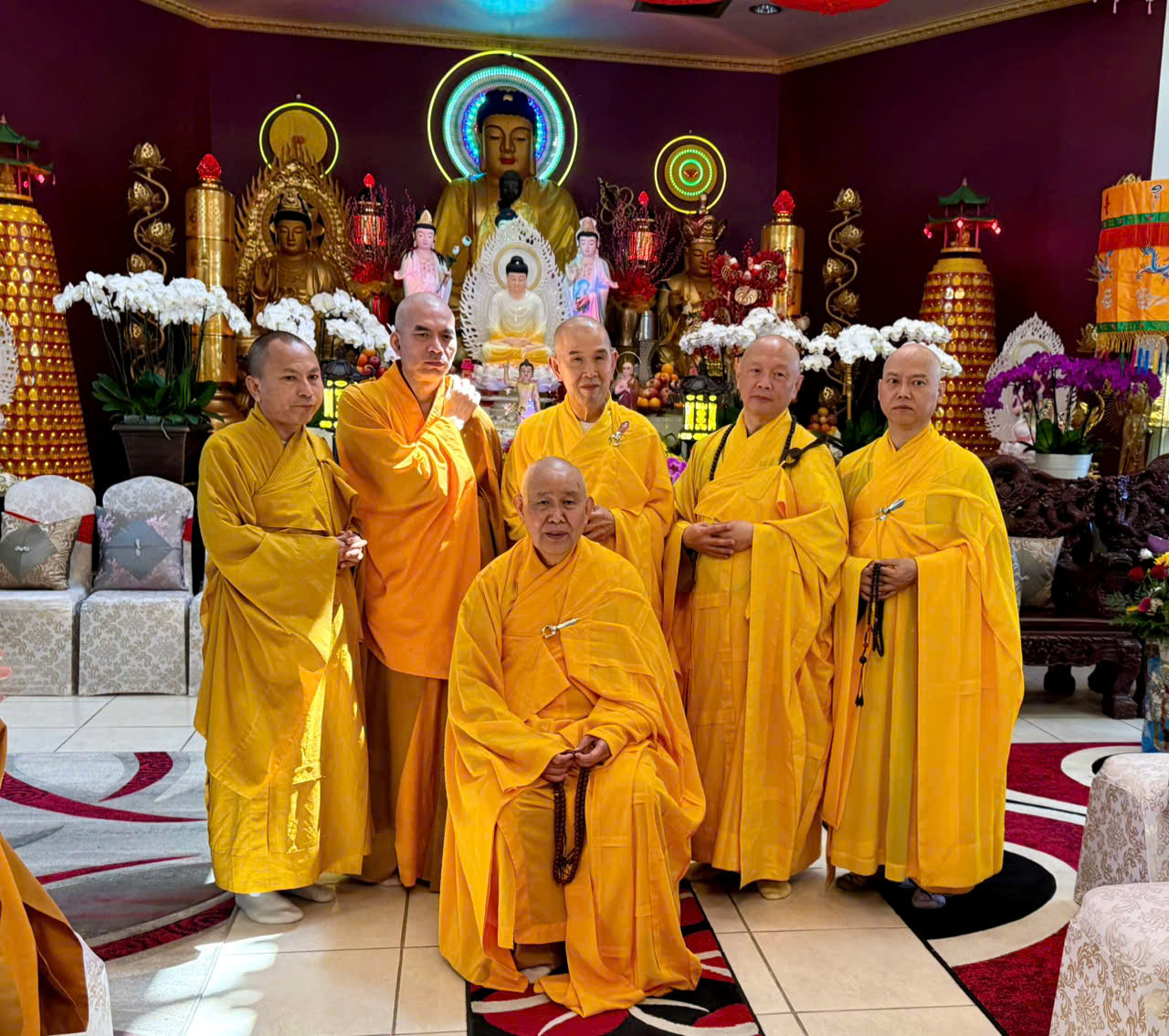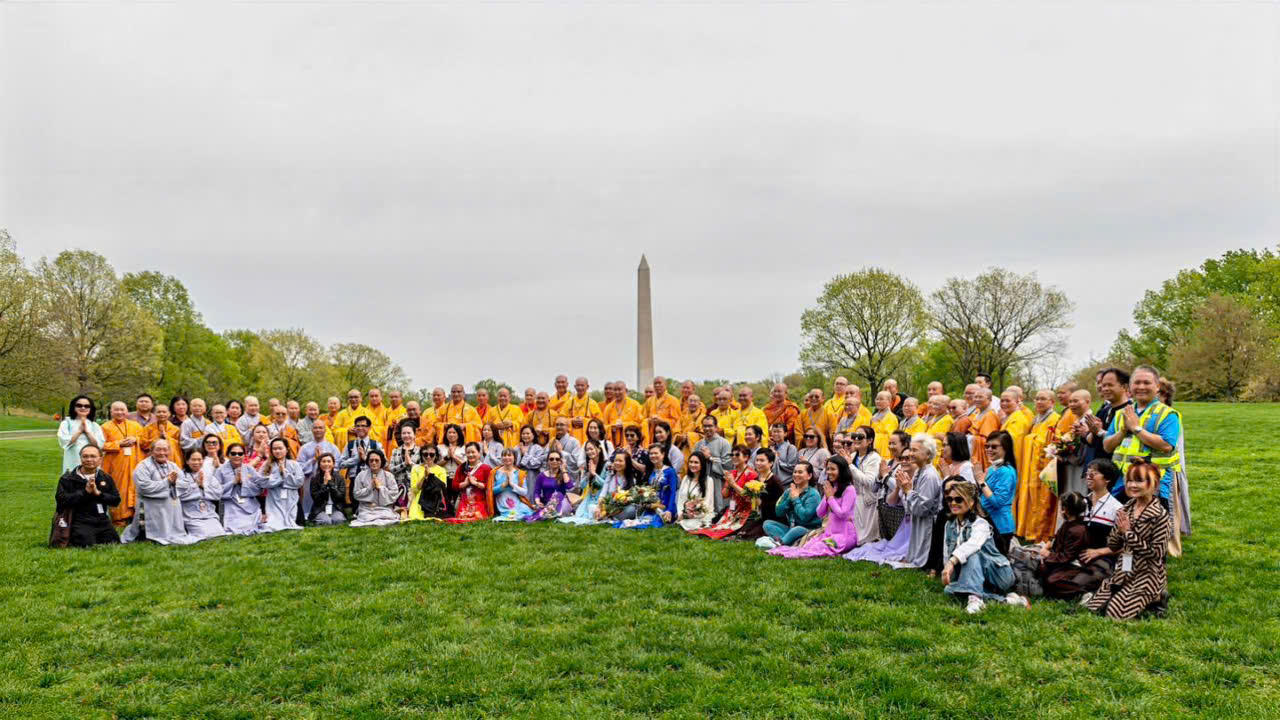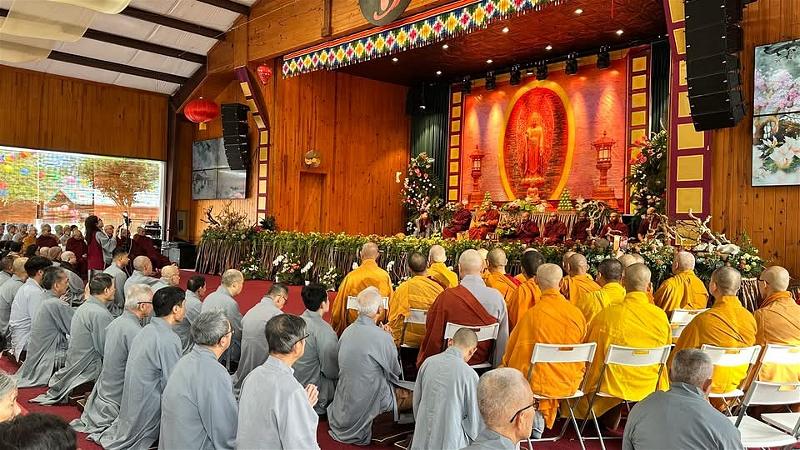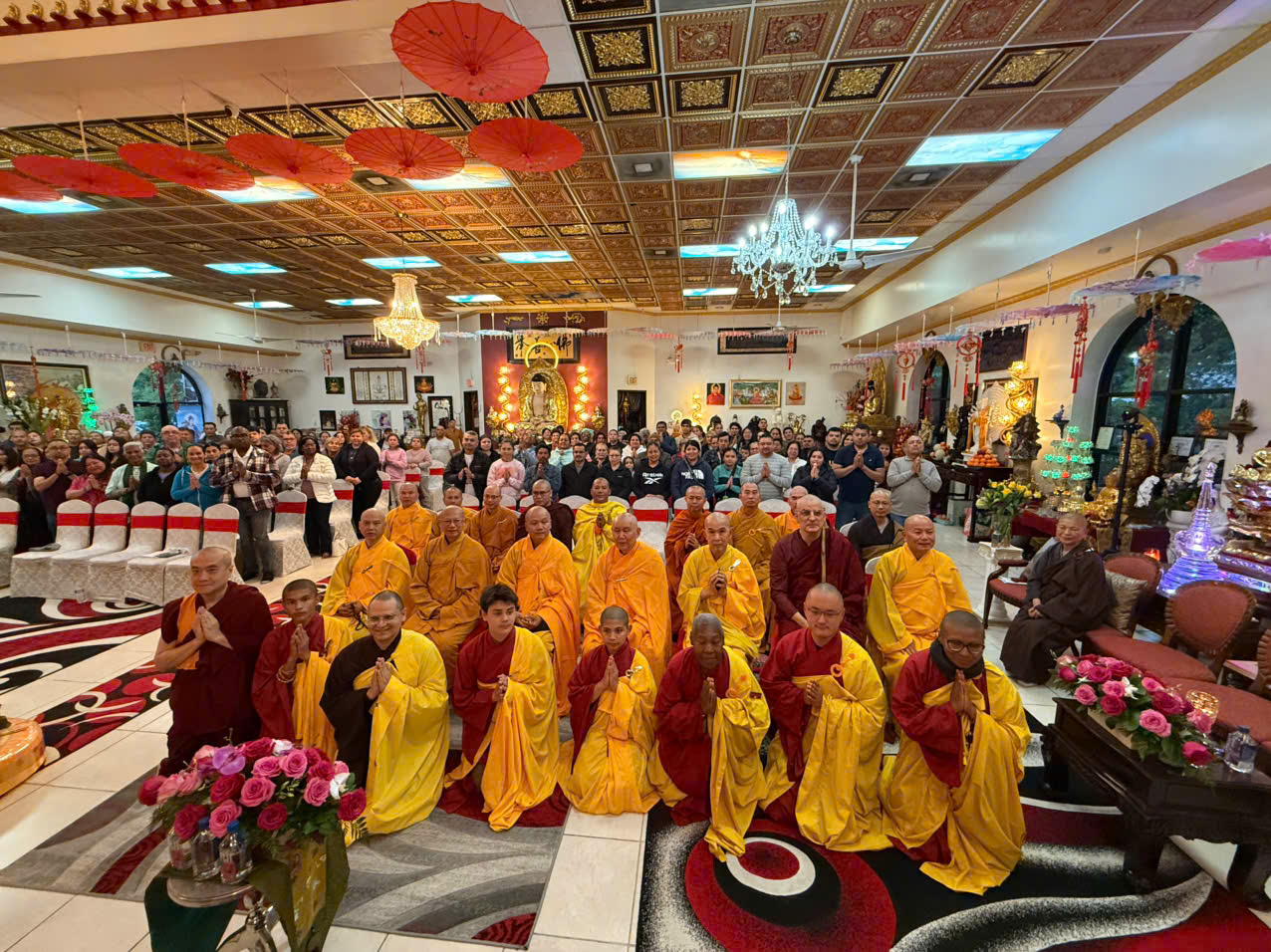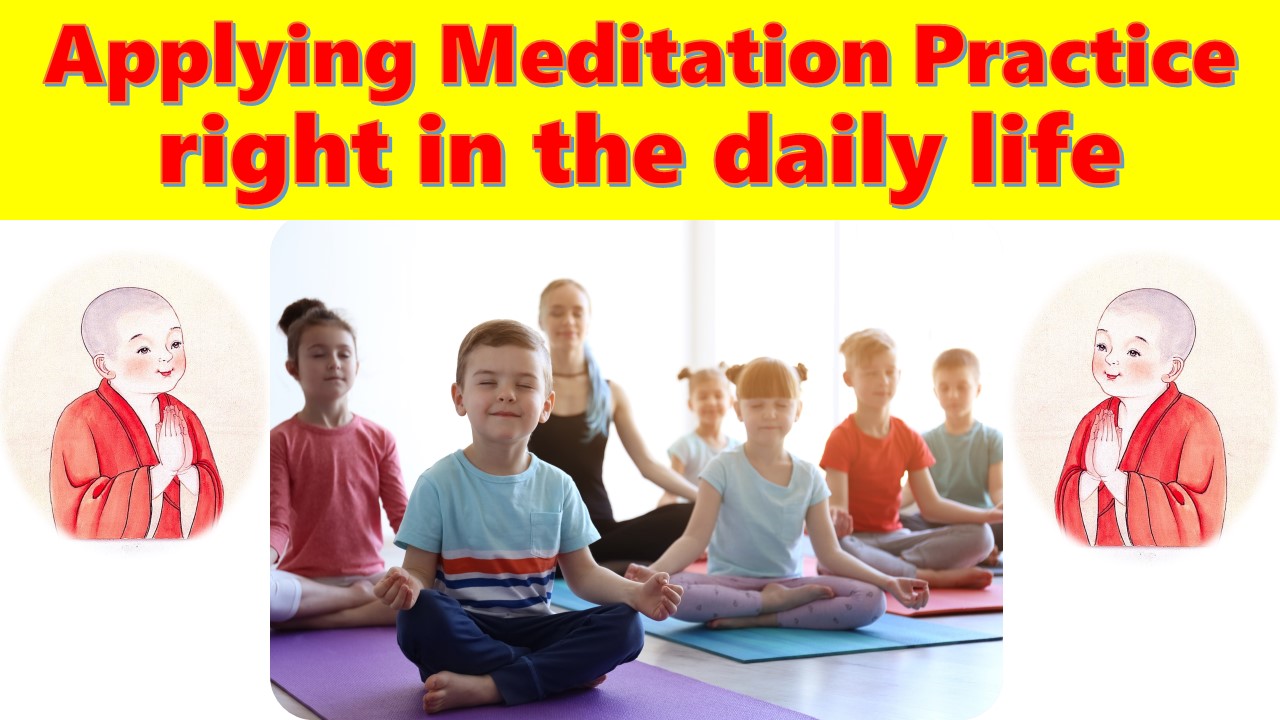
APPLYING MEDITATION PRACTICE RIGHT IN THE DAILY LIFE
Meditation is a very valuable, effective, practical practice method that helps us live a life of mindfulness, awareness, joy, and happiness right here and right now in the present life. Applying and practicing meditation daily diligently, regularly, and assiduously, we can master our clear, peaceful, and relaxed bodies and minds. As we know meditation is a spiritual food that is very necessary for our daily lives including children and adults. Whether you are religious or non-religious people, you can learn, understand, and apply meditation practice in your daily lives to benefit your bodies and minds.
Indeed, meditation is not limited to religion, it goes beyond religion. Anyone who wants to have peace of mind and peace of body can apply meditation learning and meditation practice to benefit many people. When our bodies and minds are at peace, we can bring authentic happiness and peacefulness to many people. Conversely, when our bodies and minds are irritable, angry, anxious, stressed, uncomfortable, and not peaceful, do not expect us to bring peacefulness and happiness for ourselves and for other people. Therefore, meditation is very important and necessary for everyone to apply and practice right now and here in the present life.
Meditation in the Pāli language is Jhāna. In the Sanskrit language, it is Dhyāna. In the Japanese language, it is Zen. In the Chinese language, it is Chán. In the Vietnamese language, it is Thiền.
Meditation means quietness, stillness, calmness, tranquility, mindfulness, awakening, concentration, contemplation, and single- mindedness. It is the very lively, peaceful, and helpful practice subject for one’s body and mind. Meditation has the ability to lead us to right mindfulness and awareness, and help us be aware of what is happening right here and right now in the present life, such as blue sky, white cloud, birdsong, sound of pine, flowering, murmuring stream, etc. Meditation practice has the ability to help us stop, recognize, and transform defilements of unhappiness and suffering into peaceful joy and happiness.
There are two kinds of meditation in Buddhism: they are Samatha Meditation and Vipassāna Meditation. “Samatha” in Samatha Meditation means calm, concentration, single-mindedness, or stopping. Vipassāna in Vipassāna Meditation means insight, clear seeing, lucid understanding, contemplation, or deep looking.
The word “Samatha” is almost interchangeable with the word “Samādhi,” and it originates from the same root as Sam in Samādhi. Samatha means stopping, tranquility and calm. Stopping is a method of very important practice in Samatha Meditation.
When we are sitting meditation, we hear a noise happening around us. We are very clearly aware of that noise we stop, and turn back our in-breaths and out-breaths mindfully and consciously. Breathing in, we know we are breathing in. Breathing out, we know we are breathing out. Breathing in, we know the noise is in our mind and we are noticing it. Breathing out, the noise in our mind is slowly calming and not any longer. Practicing like this a few times by following in-breaths and out-breaths mindfully and consciously, the sound we hear disappears gradually. That is Samatha Meditation.
Samatha Meditation means stopping the wandering mind and focusing it on conscious breath. As you know our minds, which are like monkeys and horses, pass from this branch to another, and run from this place to another. Sometimes we sit here, but our minds think aimlessly about New York, India, Australia, Vietnam, etc. To put our wandering minds into conscious breath by meditation practice, gradually we lead them to concentration and single-pointed mind. Do not worry when our minds travel far away. Gently put them on the conscious breaths by following the in-breaths and out-breaths deeply, slowly, relaxedly, and long.
As you know whirring is the nature of the mind; moving is the nature of the mind; stillness is the nature of the mind; concentration is the nature of the mind; relaxation is the nature of the mind, etc. The practice of Samatha Meditation is the process so that practitioners can purify and transform the minds of wandering and whirring into those of tranquility, concentration, and relaxation.
The word Vipassāna is derived from two roots: “Vi” and “Passāna.” “Vi” which is a prefix means to divide or to separate. “Vi” means to observe oneself in the method of contemplative meditation. “Passāna” means to see or to perceive. Thus, Vipassāna means to look deeply at all things and know they are impermanence, dependent origination, and no self. Vipassāna is the process of cultivating and purifying the body and the mind, and it leads practitioners to an authentically happy and peaceful life right here and right now in the present life.
Vipassāna Meditation means looking deeply at the truth of all things, clearly seeing their substances as impermanence, interdependent arising, and non-self. The process of practicing Vipassāna Meditation is the process of cultivating wisdom, bright understanding, and right view.
When practicing Vipassāna Meditation, we do not think about the past, do not lose ourselves in the future, we only know to dwell stably in mindful breathing right in the present moments. Because the past has passed, the future has not yet come, only the present moments are the wonderful moments. We dwell stably in the present moments in order to follow our in-breaths and out-breaths mindfully and consciously. When we understand and practice so regularly, we can eliminate worries, sorrows, anger, and regrets effectively.
Thanks to practicing Vipassāna Meditation, we can see that everything is impermanent, namely, greed is impermanent, anger is impermanent, delusion is impermanent, suffering is impermanent, etc. if the greed, anger, delusion, etc., are permanent, we cannot change them, but in fact, they are impermanent and changing. As awakened people who cultivate well, we can recognize and transform them step by step; transform greed into non-greed – generosity; anger into non-anger – compassion; delusion into non-delusion – wisdom; sorrow into joy; suffering into happiness by practicing saying good words, thinking of good thoughts, and doing good actions to bring authentic peaceful joy and happiness for ourselves and for other people right in this lifetime.
Cultivating Vipassāna Meditation, with the interrelated look, we can contemplate and clearly see our parents in us, children in us, sisters and brothers in us, teachers and students in us, everyone in us, and us in everyone. We see them very well in each of our cells. To apply meditation practice suitably, skillfully, and intelligently, we can invite them to practice meditation together with us in the present and precious moments. We know our happiness is their happiness, our peaceful joy is their peaceful joy, our freshness is their freshness, etc.
Practicing Vipassāna Meditation, we know our lives are always changing and impermanent; our lives will be shorter and shorter, and we live on this earth for a certain period of time, then gradually we all have to abandon this physical body and die, no one can exist on this earth forever, including the Buddha. However, being well aware of that, in order to prepare good things and baggage for life, we strive to make use of our remaining health and life to practice and generate the energies of love and understanding for ourselves and for other people right in this life.
Be aware that breathing in but without breathing out, we will pass through another life. With good karma we have well prepared, once impermanence comes, we will calmly pass away gently. When still living in the world, we are at ease. When letting go of this physical body, we and everyone around us feel at peace. Therefore, we live deeply and freely in every second, every minute, every hour, every day, every week, every month, and every year. We are aware that every breath is life, every practice is calm. Every moment is life, every moment is stable and free. When we understand and practice so regularly, we feel peaceful and happy in the present life.
Thus, samatha meditation or stopping meditation and vipassāna meditation or insight meditation, presented above are for readers and learners to easily learn, understand, remember, and easily practice. According to the interrelated look, in samatha meditation there is vipassāna meditation; and in vipassāna meditation there is samatha meditation. Samatha meditation and vipassāna meditation always go together and never separate from each other when we apply and practice meditative concentration in the daily life to bring benefits to the body and mind. However, in the process of meditation practice, we need to experience meditation learning first. When understanding meditation learning well, we will obtain the good results of meditation practice. Thanks to learning and understanding meditation clearly, it is very easy for us to lead our minds and bodies to right mindfulness and awareness, stability and calmness, peaceful joy and happiness right in the present life.
Practicing meditation regularly everyday, we can treat and relieve pains and stresses, or tensions in our bodies and minds, and we can nurture and develop the energies of loving-kindness, compassion, wisdom, joy, happiness, and peace for ourselves and others right in the present life. When spending our proper time applying meditation practice in the morning, afternoon, or evening in a certain period, we will certainly obtain the energies of peacefulness, joy, and happiness in our meditation practice daily.
From practicing meditation smoothly, what we say, what we think, and what we do can bring the flowers and fruits of authentic joy and happiness to ourselves and to other people right in this lifetime.
Learning and applying meditation practice in all the different times, places, situations and aspects into our daily lives mindfully and consciously, then we are clearly aware that when we cook rice, we know we are cooking rice. When we eat cooked rice, we know we are eating cooked rice. When we wash the dishes, we know we are washing the dishes. When driving and meeting red lights, we know we are driving and meeting the red lights and stop completely, and so on. Everything we say, think, and do that happens in our mindfulness and awareness is meditation.
While walking, standing, lying down, sitting, working, etc., in right mindfulness and clear awareness, we can all apply meditation practice. Thus, applying meditation practice in the daily life, we do not have the limit of meditation practice in sitting. With right mindfulness and calm awareness, we can apply the meditation practice to all of our daily gestures, words, actions, and activities effectively and practically right in the present life. However, in the daily life, when we apply meditation sitting longer, we will have deeper and longer mindfulness and concentration.
Indeed, as the good practitioners, the process of meditation practice is the process for us to purify, recognize, and transform the negative feelings into the positive feelings better and better. Therefore, in the daily life, apart from the three various kinds of walking meditation, standing meditation, lying meditation, or total relaxation meditation, sitting meditation to us is very important and easy to lead us to mindfulness and concentration right in our meditation practice faster and more deeply.
As a glass of unclean water is put in one place for a while, we can see the dirt in that water glass easily. Likewise, when we sit in meditation in right concentration and mindfulness, we can clearly see and identify our wandering thoughts, such as sorrow, worry, greed, anger, delusion, wrong view, ignorance, etc., and we can feel the substances of joy, peacefulness, happiness, etc., in our bodies and minds easily.
As an oil lamp is lit with a bulb wrapped around it, the light shines much more brightly.
A glass is exemplified for a meditator; unclean water is exemplified for the wandering mind; The glass of water put in a place to sit still is exemplified for the meditator who is dwelling in meditation with concentration and one-pointed mind.
The lamp is exemplified for the meditator; light of the lamp is exemplified for wisdom; the light bulb wrapped around the lamp is exemplified for right mindfulness and right concentration; the lamp which is shining is exemplified for the meditator who is dwelling stably in mindfulness, concentration, and wisdom.
Thanks to the application of diligent meditation practice and concentration, the Buddha attained perfect enlightenment under the Bodhi tree when the morning star just rose. Through his meditation practice, the light of enlightenment, peace, joy, and happiness in him became full, clear, beyond time and space right in the world.
Thus, meditation practice is always associated with mindful in-breaths and out-breaths. We know that breathing in and do not breathing out for a few short minutes, we will pass away soon. Being well aware of that, we always cherish our life, always cherish mindful and calm breathing, and always apply meditation practice in the daily life to benefit ourselves and other people right in the present life. Therefore, those who have enough good conditions meet a bright master and a good environment, and can take advantage of their appropriate time to learn, understand, practice, and apply meditation practice in the present life.
We know that the bright master is a virtuous and richly experienced teacher who has gone through well-trained classes is capable of teaching, guiding, and applying meditation practice for himself or herself and for other people in the daily life.
Traditionally, a good environment we can understand is a Temple, a Dharma center, a meditation hall, a school, an office, etc. Today, a good environment can be various Dharma classes online through ZOOM.
Through what is discussed above, applying meditation practice every day means we practice the method of watering flowers regularly every day. Every day we water flowers, then every day the flowers in us gradually become fresh and beautiful, and vice versa, every day we forget to water flowers, then every day the flowers in us will be dry and withered step by step. Thus, meditation practice is for us to water flowers every day. Meditation practice is for us to create and recharge more spiritual energies every day. When we understand and practice so regularly every day, peaceful joy and happiness have the ability to instill and cool our bodies and minds.
Likewise, we have our spiritual batteries that we carry with us for whole life. Our spiritual batteries (store consciousnesses) have the ability to store the energies of love and understanding, joy and happiness if we know how to recharge our spiritual powers by diligently applying meditation practice in our daily lives.
If every day we are lazy, distracted, and heedless, the spiritual batteries or store of consciousnesses within us can generate the energies of afflictions, greed, hatred, delusion, ignorance, hatred, anger, etc.
Indeed, every time of practicing meditation is every time of watering flowers. Every time of practicing meditation is every time of recharging more our spiritual powers. Every time of practicing meditation is every time of arousing and nurturing the seeds of enlightenment within us to sprout and rise up strongly and beautifully.
In one day, two days, or three days; in one week, two weeks, or three weeks, if we forget to water the flowers, then the flowers in us can be withered and dry; if we forget to recharge our spiritual batteries, the energy of love within us can become weaker; and if we forget to practice meditation, the energy of peacefulness within us can become less and less. At that time, certainly we do not have enough the energies of spirituality, love, understanding, peaceful joy, and happiness to share other people. Therefore, the process of cultivation is the process of accumulating and recharging more energies of spirituality, joy and happiness for oneself and for others right in this lifetime.
In the daily life, although busy doing many different things, we should not forget to water flowers, recharge more spiritual energy, and practice meditation. We are aware that watering flowers daily is necessary; recharging more spiritual energies daily is important; and applying meditation daily practice is calm. When we understand and practice so, the flowers in us become fresher and more beautiful, spiritual batteries within us become fuller and fuller, and spiritual energies within us become more abundant.
Thanks to applying meditation practice fluently, we can reap the flowers and fruits of compassion and wisdom, joy and happiness right here and right now in the present life. From applying meditation practice into everyday life, we have the ability to share and dedicate the fragrant flowers and sweet fruits, and peaceful energies to all living beings and living things on this earth.
“Peaceful blossoms instill the mind,
Flowers of loving-kindness and compassion permeate all mountains and rivers.
Each of us is every practitioner,
Donating life the fragrant flowers and delicious fruits, etc.”
By Thích Trừng Sỹ
Thus, meditation is an indispensable spiritual food in our everyday life. We can apply meditation practice in right mindfulness and awareness anywhere and anytime, such as at school, at home, in a quiet place, or in an office, even when driving and waiting for the red lights, when doing homework, composing, writing posts, when getting line to buy tickets, when shopping, etc.
Breathing in and breathing out slowly and deeply, we know we are dwelling stably and mindfully in the present moments. With conscious breathing, we breathe in; with conscious breathing, we breathe out. With mindful breathing, we breathe in; with mindful breathing, we breathe out. Breathing in, we know we are breathing in. Breathing out, we know we are breathing out. We practice so regularly everyday, the energies of loving-kindness, compassion, joy, and happiness within us grow and develop strongly.
We know that our lives are available in breaths;
Breaths are available in right mindfulness;
Right mindfulness is available in peaceful joy and happiness;
Peaceful joy and happiness are available in our bodies and minds.
Cultivating is the process of recognizing, purifying and transforming wrong into right, sorrow into joy, defilement into bodhi, suffering into peaceful joy and happiness step by step.
To cultivate is to achieve peaceful joy and happiness for oneself and for others right here and right now in the present life.
Indeed, the more we apply meditation practice in every hour, the more peaceful we feel with it in every hour. The more we apply meditation practice in everyday, the happier we feel with it in every day, and the more we apply meditation practice in every week, the more joyful and calmer we feel with it in every week. Peaceful joy is in meditation practice, happiness is in meditation practice, and freedom is in meditation practice. From practicing meditation fluently, joy and happiness have the ability to permeate and cool our bodies and minds.
In order that the sessions of meditation learning and practice become more lively, I would like to invite Dharma Sisters and Brothers to sing the following meditation song titled “I am free” happily.
“Breathing in, breathing out,
Breathing in, breathing out,
I am blooming as a flower,
I am fresh as the dew,
I am solid as a mountain,
I am firm as the earth.
I am free. I am free.
.
Breathing in, breathing out,
Breathing in, breathing out,
I am water
Reflecting
what is real, what is true
And I feel
There is space
Deep inside of me
I am free, I am free, I am free.”[1]
(Plumvillage song)
Some Basic Guidelines for Meditation Practice
Every day, you can spend 15 or 30 minutes meditating by watching your in-breaths and out-breaths, adjusting your body and mind, and walking meditation in mindfulness and awareness as follows:
At home or somewhere suitable, you can sit upright on a chair, on a couch, in a bed, or on a cushion. Depending on your preferences and choices, you can meditate in the lotus position according to the style of full lotus or half-lotus stably and calmly, put your right hand on your left hand, or your left hand on your right hand. You can put your right feet on your left thigh, or your left feet on your right thigh, bring your two thumbs in touch with each other, keep your back upright, and close your eyes.
When you feel drowsy, you can open your eyes a little bit, about one-half to stay awake and avoid falling sleepy. While sitting meditation, you relax your whole body, let go of all tensions, worries, upsets, and pains, then you feel peaceful and happy for a long time.
The cushion for meditation sitting

The way of sitting in cross-legged lotus position on the cushion with two thumbs touching together

The way of sitting in half cross-legged lotus position on cushion with two thumbs touching together

The way of sitting normally on a cushion with two thumbs touching together

The way of sitting in meditation on a chair keeping your back upright

The way of sitting in meditation according to the Japanese style keeping your back upright

The way of sitting half cross-legged in lotus position with both relaxing hands on the knees
When breathing in, you know your abdomen is rising. When breathing out, you know your abdomen is falling. You keep following your in-breaths and out-breaths slowly, naturally, regularly, comfortably, and mindfully from beginning to end through the air in and out of your conscious nostrils. Be aware that holding your in-breaths and out-breaths consciously and mindfully through your nostrils is an ongoing process during your meditation practice.
In the process of applying meditation practice, with mindfulness and awareness, you are aware of breathing in and out gently, slowly, gradually, and steadily. When you breathe in, you bring more peaceful energy. When you breathe out, you let go of tension, pain, and depression in you. Applying meditation practice regularly like that, you feel calm, relaxed, and peaceful right in the present moments.
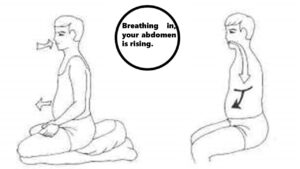
Breathing in, your abdomen is rising.
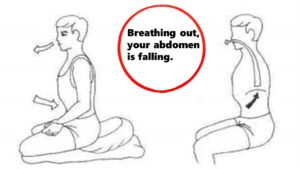
Breathing out, your abdomen is falling.
 When meditating, you keep your back upright, eyes closed, mouth closed, relax your whole body, follow your in-breaths and out-breaths mindfully and consciously to keep your facial expressions light and fresh. Moreover, during meditation sitting, if you feel drowsy, you can partially open your eyes to keep you more awake.
When meditating, you keep your back upright, eyes closed, mouth closed, relax your whole body, follow your in-breaths and out-breaths mindfully and consciously to keep your facial expressions light and fresh. Moreover, during meditation sitting, if you feel drowsy, you can partially open your eyes to keep you more awake.
Some typical images are presented and instructed above, you can apply and choose for yourself an appropriate practice method to help your body and mind feel peaceful, gentle, and relaxed during the process of meditation practice.
On the other hand, during meditation practice, if you hear a sound of a car, a sound of a motorcycle, a sound of a barking dog, etc., you recognize that sound in your minds for a few seconds, and then you bring your minds back to your in-breaths and out-breaths mindfully and consciously.
While you are meditating, there is the scent of flowers, the scent of fruit, or the scent of something else happening to your nose. You can record that scent for a few seconds, return to your breath, continue to monitor your in-breaths and out-breaths slowly, deeply, regularly, comfortably, and mindfully from the beginning to the end through the in-airflows and out-airflows from your conscious nostrils. You feel calm, peaceful, and happy right in the present moments.
Or while you are sitting meditation, you feel itchy. You slowly bring your hand to the itchy spot, and scratch it softly. When you finished scratching, you slowly bring and place your hand back into your palms. At that time, the pleasant feelings in your bodies and minds arise, you recognize them and continue following your in-breaths and out-breaths mindfully. When sitting meditation, your legs become numb and uncomfortable, you recognize the feelings of numbness and discomfort for about a few seconds and minutes. You gently and mindfully change your sitting postures, and then you continue to maintain the pleasant feelings in you.
When sitting meditation, you want to stand up to go for walking meditation, first open your eyes and rub your hands together, put your hands on your face, and gently massage your face and head two or three times, and then, you lift and straighten your legs, move your bodies slowly, and start standing up in mindfulness. You walk step by step and know that every step is stable, every step is free, every step is life, every step is peaceful, and every step is joyful.
When applying such a regular meditation every hour, every day, every week, every month, and every year, you can enjoy Dharma learning, Dharma practice, Dharma understanding, Dharma joy, Dharma happiness, and Dharma achievement right now and right here in the present life. Indeed, when you understand and practice so regularly, you will be fresh flowers to beautify this world.
Breathing in, I know I am breathing in,
Breathing out, I know I am breathing out
In and out. (Bell)
.
Breathing in, I know I am alive and sitting here.
Breathing out, I know I am still alive and sitting here practicing meditation together with Dharma Sisters and Brothers today.
In and out. (Bell)
.
Breathing in deeply, I know I am breathing in deeply.
Breathing out slowly, I know I am breathing out slowly.
In and out. (Bell)
.
Calming bodily action, I am breathing in,
Calming bodily action, I am breathing out.
In and out. (Bell)
.
Calming mental action, I am breathing in,
Calming mental action, I am breathing out.
In and out. (Bell)
.
Calming verbal action, I am breathing in,
Calming verbal action, I am breathing out.
In and out. (Bell)
.
Feeling the whole body, I am breathing in,
Feeling the whole body, I am breathing out.
In and out. (Bell)
.
Feeling the whole mind, I am breathing in,
Feeling the whole mind, I am breathing out.
In and out. (Bell)
.
Be aware of the whole body, I am breathing in,
Be aware of the whole body, I am breathing out.
In and out. (Bell)
.
Be aware of the whole mind, I am breathing in,
Be aware of the whole mind, I am breathing out.
In and out. (Bell)
.
Breathing in, I know I am practicing meditation for myself, for my parents, sisters, brothers, and for my children
Breathing out, I know I would like to invite my parents, sisters, brothers, and my children to practice meditation and learn the Dharma with me.
In and out. (Bell)
.
Breathing in, I know I am charging my spiritual battery
Breathing out, I know my spiritual battery gets fuller and fuller.
In and out. (Bell)
.
Breathing in, I know I am practicing the method of watering flowers
Breathing out, I know flowers in me get fresher and fresher.
In and out. (Bell)
.
Breathing in, I know, every day I forgot to charge my spiritual battery, my spiritual battery will become weaker and weaker
Breathing out, I know, every day I forgot to water flowers, flowers in me will be more and more withered.
In and out. (Bell)
.
Breathing in, I know every breath is life
Breathing out, I know every practice is calm and relaxed.
In and out. (Bell)
.
Breathing in, I know, every day my life is shorter and shorter
Breathing out, I know, every day my health is weaker and weaker.
In and out. (Bell)
.
Breathing in, I know I am making use of the rest of my life to practice the Buddhadharma more and more diligently
Breathing out, I know I am making use of the rest of my health to apply the Buddhadharma into my daily life to benefit myself and other people right here and right now in the present life.
In and out. (Bell)
.
Breathing in, I contemplate that all living things and living beings on earth are changing and impermanent
Breathing out, I contemplate they are arising and ceasing continuously, and never stopping.
In and out. (Bell)
.
Breathing in, I feel well and healthy
Breathing out, I feel calm and peaceful.
Well, healthy, calm, and peaceful.
In and out. (Bell, bell, bell)
Meditation application anywhere
Right Mindfulness and awareness are wonderful in us.
Let’s practice meditation together with everyone
Bring benefits as gifts for the many
We practice meditation warmly
The mind and body of peace and joy from inside to outside.
Happy practitioners practice forever
Compassion and wisdom shine everywhere.
We wish you all success and diligence in your meditation practice.
By Thích Trừng Sỹ


